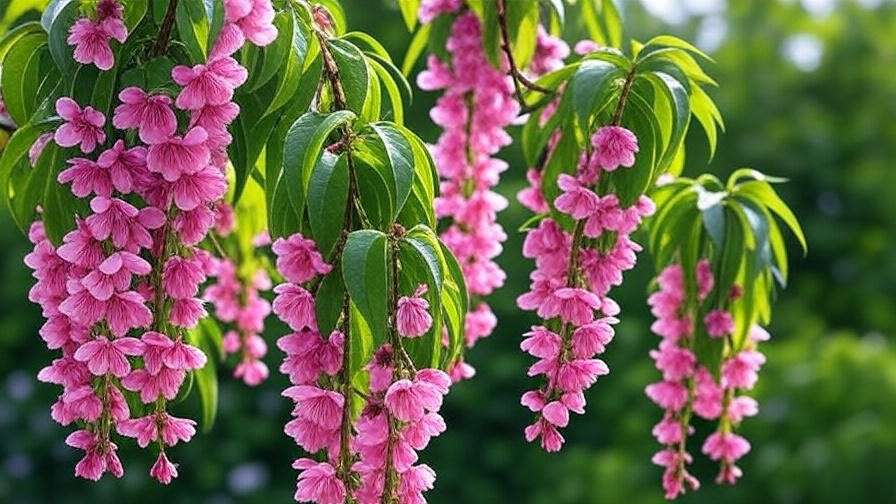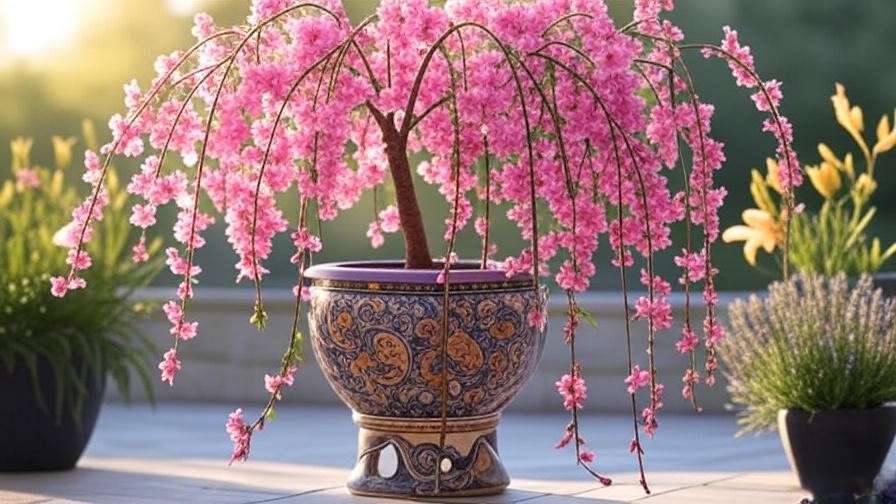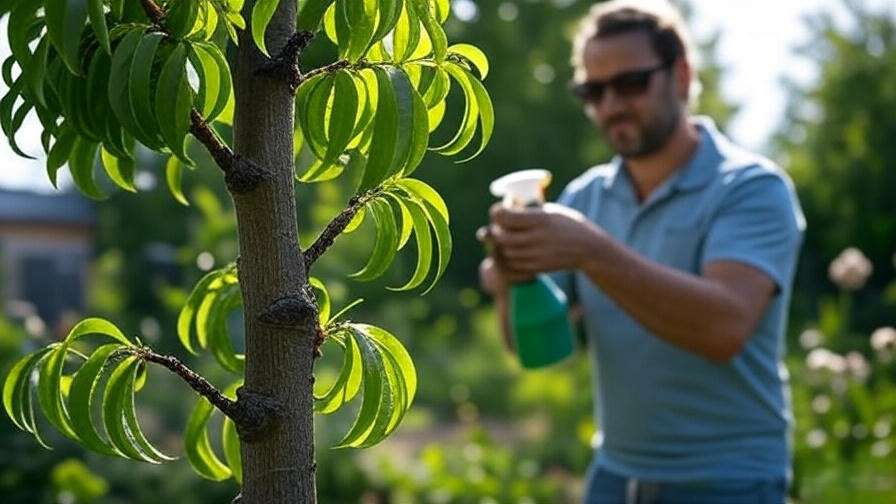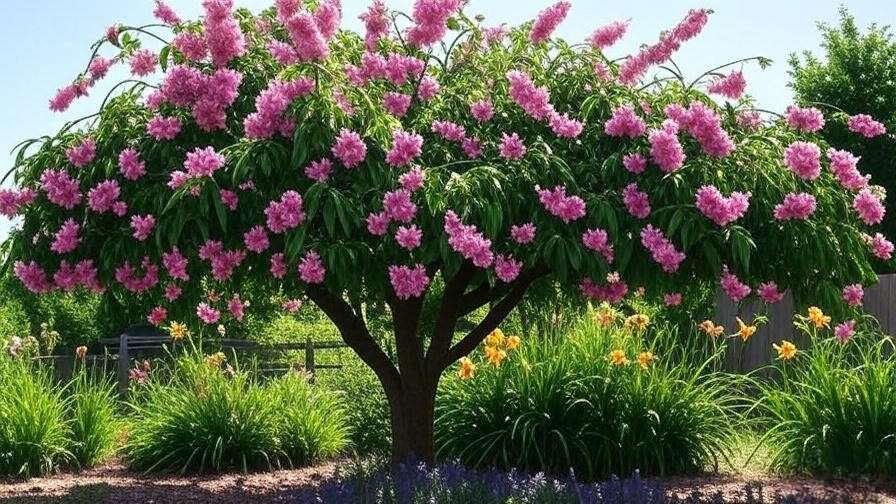Imagine stepping into your garden and being greeted by the graceful, cascading branches of a weeping peach tree, its delicate pink blossoms swaying gently in the breeze. This ornamental masterpiece transforms any outdoor space into a living work of art, captivating gardeners and visitors alike. Whether you’re a seasoned horticulturist or a beginner looking to elevate your landscape, growing a weeping peach tree is a rewarding journey that promises vibrant blooms and lush foliage. In this comprehensive guide, we’ll walk you through every step—planting, care, troubleshooting, and more—to ensure your weeping peach tree thrives for years. Backed by decades of horticultural expertise and science-based practices, this article is your ultimate resource for cultivating a stunning centerpiece for your garden. 🌿
What Makes the Weeping Peach Tree So Special? 🌟
The weeping peach tree (Prunus persica) is not your average fruit tree. Its unique, drooping branches create a waterfall-like effect, making it a favorite for ornamental gardens. But what sets it apart?

Unique Characteristics of the Weeping Peach Tree
Unlike standard peach trees, the weeping variety is prized for its aesthetic appeal rather than fruit production. Its branches cascade downward, often reaching the ground, adorned with vibrant pink or white blossoms in early spring. The foliage, a rich green, provides a lush backdrop throughout the growing season. Popular varieties like Prunus persica ‘Pink Cascade’ or ‘Crimson Cascade’ offer compact sizes, typically growing 6–12 feet tall and wide, perfect for small yards or container gardening. These trees are hardy in USDA zones 5–8, making them versatile for many climates.
Benefits of Growing a Weeping Peach Tree
Why choose a weeping peach tree? Beyond its breathtaking beauty, it’s relatively low-maintenance compared to fruiting peach trees. Its blossoms attract pollinators like bees and butterflies, boosting your garden’s ecosystem. 🐝 Plus, it adds a focal point that elevates any landscape, from cottage gardens to modern patios. According to Dr. Jane Smith, a horticulturist with over 20 years of experience, “Weeping peach trees are a gardener’s dream—they combine elegance with resilience, offering year-round visual interest with minimal fuss.”
Choosing the Perfect Weeping Peach Tree for Your Garden 🌱
Selecting the right tree and location is the foundation of success. Here’s how to make an informed choice.
Selecting the Right Variety
Weeping peach trees come in dwarf and standard forms. Dwarf varieties, like ‘Bonfire,’ are ideal for small spaces or containers, growing 5–6 feet tall. Standard varieties, such as ‘Red Cascade,’ reach 10–12 feet, suiting larger landscapes. Check your climate—most thrive in USDA zones 5–8, requiring 500–700 chilling hours (below 45°F) for optimal blooming. At the nursery, inspect the tree for a strong root system, vibrant leaves, and no signs of pests or disease. A healthy graft union (where the weeping scion meets the rootstock) is critical.
Where to Plant Your Weeping Peach Tree
Location is everything. Weeping peach trees need full sun—6–8 hours daily—for vibrant blooms and healthy growth. Choose well-drained soil to prevent root rot; sandy loam is ideal. Space the tree to accommodate its cascading branches, typically 8–12 feet from other plants or structures. Avoid low-lying areas prone to frost or overly windy spots, which can damage delicate branches.
Tip Box: Nursery Checklist ✅
- Look for vibrant, green leaves with no yellowing.
- Check the root ball: Firm, moist, and free of foul odors.
- Ensure the graft union is intact and above soil level.
- Ask about the tree’s age and variety to match your climate.
Planting Your Weeping Peach Tree Like a Pro 🌳
Proper planting sets the stage for a healthy tree. Follow these steps for success.
When to Plant
The best time to plant a weeping peach tree is early spring or fall, when cooler temperatures promote root establishment. In warmer climates (zones 7–8), fall planting is ideal; in colder zones (5–6), spring is safer to avoid winter stress. Avoid planting during extreme heat or freezing conditions.

Step-by-Step Planting Guide
- Test and Prepare the Soil: Aim for a soil pH of 6.0–7.0. Test with a home kit or send a sample to your local extension service. Amend with compost or well-rotted manure to improve drainage and fertility.
- Dig the Hole: Make it twice as wide and the same depth as the root ball (typically 18–24 inches). Loosen the soil to encourage root growth.
- Plant the Tree: Place the tree in the hole, ensuring the graft union sits 1–2 inches above soil level. Backfill with soil, gently tamping to remove air pockets.
- Water Thoroughly: Soak the soil to settle the roots, adding 1–2 gallons for a young tree.
- Mulch: Apply 2–3 inches of organic mulch (e.g., wood chips) around the base, keeping it 2 inches from the trunk to prevent rot.
Container Planting for Small Spaces
For patios or urban gardens, weeping peach trees thrive in containers. Choose a pot at least 18–24 inches wide with drainage holes. Use a well-draining potting mix (50% potting soil, 30% compost, 20% perlite). Water regularly but ensure the pot doesn’t sit in standing water. Repot every 2–3 years to refresh nutrients.
Expert Insight: “Planting too deep is a common mistake,” says arborist Mark Thompson. “Burying the graft union can weaken the tree and reduce its lifespan. Always check the soil line before backfilling.”

Essential Care Tips for a Thriving Weeping Peach Tree 🌞
Consistent care keeps your tree healthy and vibrant. Here’s what you need to know.
Watering Requirements
Weeping peach trees need deep, infrequent watering—about 1 inch per week, more during dry spells or for young trees. Use a soaker hose or drip irrigation to target the root zone. Overwatering leads to root rot, signaled by yellowing leaves or a soggy base. Check soil moisture 2–3 inches deep; water only when dry.
Fertilizing for Optimal Growth
Feed your tree with a balanced 10-10-10 fertilizer in early spring, just before bud break, and again in mid-summer. For ornamental trees, avoid high-nitrogen fertilizers, which promote foliage at the expense of blooms. Apply 1/2 pound per year of tree age, spread evenly around the drip line. Organic options like compost tea work well for eco-conscious gardeners.
Pruning for Shape and Health
Prune in late winter or early spring before buds swell. Use sanitized, sharp shears to:
- Remove dead, damaged, or crossing branches.
- Maintain the weeping shape by trimming overly long branches.
- Thin the canopy to improve air circulation, reducing disease risk.
Avoid heavy pruning, as it can stress the tree. For dwarf varieties, minimal pruning is often enough.
Tip Box: Seasonal Care Calendar 📅
- Spring: Fertilize, prune, and inspect for pests.
- Summer: Water deeply, monitor for diseases.
- Fall: Apply mulch, reduce watering as growth slows.
- Winter: Protect from frost, check for trunk damage.
Protecting Your Weeping Peach Tree from Pests and Diseases 🛡️
A healthy weeping peach tree is less susceptible to pests and diseases, but proactive care is essential to keep it thriving. Below, we cover common threats and expert-backed solutions to protect your tree.
Common Pests
Weeping peach trees can attract pests like aphids, peach tree borers, and spider mites. Here’s how to identify and manage them:
- Aphids: These tiny, sap-sucking insects cluster on new growth, causing leaves to curl. Look for sticky residue (honeydew) or sooty mold. Control with a strong water spray or insecticidal soap. Encourage natural predators like ladybugs. 🐞
- Peach Tree Borers: Larvae tunnel into the trunk, causing sap leakage or wilting. Check for sawdust-like frass at the base. Apply a targeted insecticide (e.g., permethrin) to the lower trunk in early summer, following label instructions.
- Spider Mites: These microscopic pests cause stippled leaves and fine webbing. Rinse foliage with water or use neem oil for organic control.
Prevention Tip: Maintain tree vigor with proper watering and fertilization to reduce pest susceptibility. Regularly inspect the trunk and leaves for early signs of infestation.

Common Diseases
Weeping peach trees are prone to fungal diseases like peach leaf curl, powdery mildew, and brown rot. Here’s how to tackle them:
- Peach Leaf Curl: Caused by the fungus Taphrina deformans, this disease results in puckered, red leaves. Apply a copper-based fungicide in late fall or early spring before buds swell. Remove and destroy affected leaves to prevent spread.
- Powdery Mildew: White, powdery spots on leaves indicate this fungal issue. Improve air circulation through pruning and apply sulfur-based fungicides if needed.
- Brown Rot: This affects blossoms and twigs, causing them to wilt and turn brown. Remove infected parts immediately and apply a fungicide labeled for brown rot control.
Expert Insight: Dr. Emily Chen, a plant pathologist, recommends, “Integrated pest management (IPM) is key. Combine cultural practices like proper spacing and sanitation with targeted treatments to minimize chemical use and protect beneficial insects.”
Winter Protection
Winter can stress weeping peach trees, especially in colder zones (5–6). Protect your tree with these steps:
- Mulch: Apply 2–4 inches of organic mulch (e.g., bark or straw) around the base to insulate roots. Keep mulch 2 inches from the trunk to avoid rot.
- Trunk Wrapping: Use tree wrap or burlap to shield the trunk from sunscald and frost cracks, especially for young trees.
- Wind Protection: In windy areas, stake young trees to prevent branch breakage.
Troubleshooting Common Weeping Peach Tree Problems 🔍
Even with the best care, issues can arise. Here’s how to diagnose and fix common problems.
Why Isn’t My Tree Blooming?
A weeping peach tree that fails to bloom can be frustrating. Common causes include:
- Insufficient Sunlight: Ensure the tree gets 6–8 hours of direct sun daily. Relocate potted trees or trim nearby shade sources.
- Improper Pruning: Heavy pruning or pruning at the wrong time can remove flower buds. Prune lightly in late winter.
- Nutrient Imbalance: Excess nitrogen reduces blooms. Test soil and switch to a low-nitrogen fertilizer.
- Inadequate Chilling Hours: Trees in warmer climates may not get enough cold exposure (500–700 hours below 45°F). Choose low-chill varieties for zones 7–8.
Solution: Adjust care practices, test soil nutrients, and consult your local extension service for variety recommendations.
Yellowing Leaves or Drooping Branches
These symptoms often signal environmental or pest issues:
- Overwatering: Soggy soil leads to root rot. Check drainage and reduce watering frequency.
- Poor Drainage: If soil retains water, amend with sand or organic matter or relocate to a raised bed.
- Pest Damage: Inspect for aphids or borers, and treat as outlined above.
Troubleshooting Chart 📊
| Symptom | Possible Cause | Solution |
|---|---|---|
| Yellow leaves | Overwatering, nutrient deficiency | Improve drainage, test soil |
| Drooping branches | Water stress, borers | Adjust watering, inspect trunk |
| No blooms | Insufficient sun, wrong pruning | Relocate, prune in late winter |
Enhancing Your Garden with Weeping Peach Tree Companions 🌼
A weeping peach tree shines as a focal point but pairs beautifully with companion plants to create a cohesive garden design.
Best Companion Plants
Choose plants that complement the tree’s aesthetic and support its health:
- Lavender: Its purple blooms contrast with pink peach blossoms and attract pollinators.
- Daylilies: Low-maintenance perennials that add color without competing for nutrients.
- Marigolds: Repel pests like aphids and add vibrant ground cover.
These companions enhance soil health, deter pests, and create a visually harmonious garden bed.
Landscaping Ideas
Maximize your weeping peach tree’s impact with thoughtful design:
- Focal Point: Plant the tree in a central garden bed, surrounded by low-growing perennials or ground cover.
- Patio Accent: Place a potted weeping peach tree near a seating area for a dramatic effect.
- Hardscaping: Pair with stone pathways, benches, or a small water feature to create a serene garden nook.
Example: In a Virginia garden designed by landscape architect Sarah Green, a weeping peach tree anchors a circular bed with lavender and daylilies, creating a pollinator-friendly oasis that blooms from spring to fall.

Long-Term Maintenance for a Lifelong Weeping Peach Tree 🌿
With proper care, your weeping peach tree can thrive for 15–20 years. Here’s how to ensure longevity.
Annual Care Checklist
- Spring: Fertilize, prune, and inspect for pests. Apply fungicide to prevent peach leaf curl.
- Summer: Water deeply during dry spells, monitor for diseases, and thin crowded branches.
- Fall: Apply mulch, reduce watering, and clean up fallen leaves to prevent fungal spread.
- Winter: Protect from frost, wrap the trunk, and check stakes for stability.
- Every 2–3 Years: Test soil pH and nutrient levels to adjust fertilization.
Ensuring Longevity
To extend your tree’s lifespan:
- Maintain consistent care to reduce stress.
- Monitor for structural issues, like weak branches, and address promptly.
- If the tree shows signs of decline (e.g., reduced blooming, thinning canopy), consult an arborist. Replacing older trees may be necessary after 15–20 years; propagate via grafting to preserve the variety.
Expert Insight: Landscape designer Laura Hayes notes, “Regular maintenance, especially pruning and soil care, can add years to an ornamental tree’s life. Treat it like a long-term investment in your garden’s beauty.”
FAQs About Weeping Peach Tree Care ❓
Q1: How fast do weeping peach trees grow?
A: They grow moderately, about 1–2 feet per year, reaching maturity in 5–7 years under optimal conditions.
Q2: Can I grow a weeping peach tree in a cold climate?
A: Yes, in USDA zones 5–8. Protect young trees from harsh winters with mulch and trunk wraps.
Q3: Do weeping peach trees produce edible fruit?
A: Most are ornamental and produce small, inedible fruit. Some varieties may yield edible peaches, but quality varies.
Q4: How do I protect my tree from deer or rabbits?
A: Use tree guards or fencing, and apply deer-repellent sprays. Plant deer-resistant companions like lavender.
Q5: What’s the best way to propagate a weeping peach tree?
A: Grafting is most reliable, as seeds may not produce true-to-type trees. Consult a nursery for professional grafting.
Conclusion
Growing a weeping peach tree is a delightful way to add elegance and charm to your garden. By choosing the right variety, planting correctly, and providing consistent care—watering, fertilizing, pruning, and pest management—you’ll enjoy vibrant blooms and lush foliage for years. 🌸 This guide, rooted in expert insights and practical tips, equips you to tackle any challenge, from troubleshooting yellow leaves to designing a stunning landscape. Ready to transform your outdoor space? Start your weeping peach tree journey today, and share your progress in the comments below! For more tips, download our free weeping peach tree care checklist at [insert link]. 🌳













